
LANSING, Mich. (AP) — A crayfish that reproduces by cloning has been added to Michigan’s prohibited species list.
All known specimens of marbled crayfish are genetically identical females that can produce up to 700 eggs per reproductive cycle without the need for fertilization, according to the state Department of Natural Resources.
The species’ reproductive capacity and aggressive nature may allow them to dominate lakes, ponds and rivers quickly.
They have not been detected in the wild in Michigan, but the state said a single marbled crayfish that escapes captivity or is released into open water could have the potential of initiating an entire population. They feed on plants, snails and amphibians, limiting food sources for fish and other aquatic species.

In captivity, marbled crayfish can exhibit a range of colors including blue or red. Most specimens found in the wild are olive to brown in color. (Photo courtesy of Mari-Liis Komets via Michigan DNR.)
Marbled crayfish, also known as virgin crayfish, are popular in the aquarium trade. They range from 4 to 5 inches (10 to 12 centimeters) long, have slender claws and feature a marbled coloration pattern on their backs.
As part of Michigan’s prohibited species list, they cannot be owned, introduced, imported, traded, sold or offered for sale as a live organism in Michigan, with few exceptions. Also, they shouldn’t be flushed down the toilet.
“Disposing of marbled crayfish by releasing them into the wild should not be considered,” said Lucas Nathan, DNR aquatic invasive species coordinator. “Their ability to move across land also increases their risk of spread.”
The species’ addition to the list aligns Michigan with the Conference of Great Lakes and St. Lawrence Governors and Premiers’ list of “least wanted” aquatic invasive species that pose a serious threat to the environment and economy in the Great Lakes-St. Lawrence River region.
Watch the Great Lakes Now segment on zebra mussels, another Great Lakes invasive species:
API key not valid. Please pass a valid API key.Featured image: Marbled crayfish are named for the streaked or marbled appearance of the shell and claws. (Photo courtesy of Ranja Adriantsoa via Michigan DNR.)




